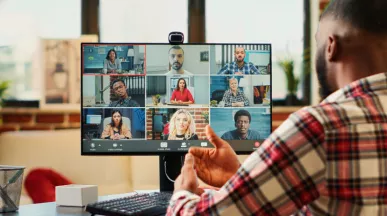Generational Diversity: How to Attract and Retain Talent of All Ages

By Sylena McClendon
October is Global Diversity Awareness Month and an oft-overlooked — but still very much key — component of workplace diversity is age. Creating strategies to encourage generational diversity is crucial to DEI success.
October is Global Diversity Awareness Month and an oft-overlooked — but still very much key — component of workplace diversity is age. Creating strategies to encourage generational diversity is crucial to DEI success.
The generational differences in the makeup of the workforce is shifting rapidly. Just a few years ago, Millennials became the biggest segment in the workforce at 35%. In another few years, the oldest Generation X workers will reach retirement age, and the proportion of Gen Z in the workplace could grow to 30% by 2030. Employers need intentional strategies to attract, engage, and retain a multigenerational workforce.
Why is it so important to foster generational diversity in the workforce? In addition to knowledge sharing, generational diversity, “decreases employee turnover expenses, increases potential client base, and improves succession planning for retirement,” according to LinkedIn.
Historically, employers have thought of each generation as having its own unique needs and priorities but current trends in the talent market suggest a values-based approach that cuts across generational lines as this can have a broader reach and a bigger impact. McKinsey recently outlined new candidate profiles that highlight values and motivations, which can help employers more effectively attract different kinds of workers.
How Generation-based Profiles Can Get in Our Way
You can’t really classify what a worker wants based on how old they are, because everyone is unique—motivators and personality types are not exclusive to any particular age group. Many different factors influence what motivates a person, including the stage of life, location, socio-economic status, personal and professional goals, personality, number of dependents, marital status, and countless other variables.
Age-based profiles can easily lead to stereotyping and ageism. We’ve all seen memes about Gen Zers repeatedly showing Boomer leaders how to PDF a document or deal with some other technological challenge. Generalizing people’s abilities based on these stereotypes is very likely to limit your talent pool.
What Actually Motivates Your Ideal Employees
Chances are, many of your best or ideal employees share similar motivations regardless of when they were born. That said, not everyone in your organization needs the same motivations in order to achieve success. Understanding different types of employee motivation strategies helps you shape internal and external messaging, and create programs that deliver what employees need to be happy and successful in your organization.
Here’s a look at many common motivators employers should pay attention to and consider adding or expanding.
Day-to-day work: What is the employee experience actually like? Many workers are motivated by a healthy work culture, challenging work, meaningful contributions, clear expectations, structure, access to the latest technology, and transparent leadership. Inspirus Connects facilitates many of these motivators, by making it easy to communicate consistently across your organization and regardless of where your employees work.
Financial: Do your employees feel financially secure and empowered? Offering monetary rewards, flexible retirement planning, 401k matching, bonuses and stock sharing, and tuition reimbursement are just a few ways to contribute to your employees’ financial wellness and education.
Recognition: Do your employees feel seen, heard, and valued? Supply your employees with a vehicle for peer recognition, recognition from supervisors, and experiential rewards to help them feel their expertise is acknowledged and valued. Here are three unique employee recognition ideas to get you started.
Career advancement: Are you supporting your employees’ futures? Many top-performing employees are motivated by professional development opportunities, skills training, online training and certification programs, mentoring, and promotions. Some may also have a strong desire to be in a position of authority or achieve a prestigious job title.
Work/life integration: Are employees able to manage stress effectively? Most of today’s workers, regardless of age, want a say in their work schedule and location. Offering expanded paid time off (PTO) and sabbaticals can help employees better balance the demands of their work and personal lives, allowing them to be more present in both areas.
Recognizing the Types of Employees You Have and Want
The goal is to think of and treat everyone as an individual. Get to know your employees and recognize that each of them may have different personality traits. Once you do that, it’s important to honor their differences. This can help inform your talent acquisition and employee engagement strategies, particularly when it comes to messaging.
Here are some traits that future employees might have — both positive and negative — that your employee engagement strategies need to address.
- Ambitious
- Goal-oriented
- Independent worker
- Collaborator
- Team player
- Loyal
- Work-centric
- Cynical
- Entrepreneurial
- Service-oriented
- Multi-tasker
- Introverted
- Extroverted
Best Practices for Treating Workers as Individuals
Some leaders are natural experts at helping others feel seen, heard, and valued. Others need to learn and practice the skill — but it’s possible and very much worthwhile. In general, this is about prioritizing ways to treat workers as individuals who have individual preferences, needs, and styles of preferred learning and management. Here are some of the strategies you can use to foster a more inclusive culture and inspire higher levels of employee engagement.
Ask the right questions. Host one-on-one meetings with your direct reports and team, and lead with curiosity. Ask them what motivates them the most. Is it more money, a more flexible schedule, or something entirely different?
Collect and evaluate feedback. Perform regular employee surveys and really analyze the data to identify trends as well as outliers. Then, be prepared to use those insights to inform an action plan when necessary. By doing this, you are learning how to improve team culture.
Lead with kindness. Embrace an open door policy in practice, not just in name only. Foster a culture of kindness and understanding within your team and workplace so that people feel encouraged to come to you for help and support, and to talk about what they need to be happy and productive at work.
Be transparent. Say what you mean, mean what you say, and follow through with your promises. Another powerful way to be transparent and authentic is to apologize when you make a mistake. Making these efforts is an effective way of changing corporate culture.
Generational Diversity is a Winning Business Strategy
Actively supporting and aiming for generational diversity in the workplace isn’t just about making people happy or doing the right thing. It’s also, as we mentioned before, linked with better business outcomes. Effectively, generational differences in the workplace is one of those win-win-win goals that benefits everyone involved—but it doesn’t happen by chance, especially as time marches on. With the right mindset and strategies in place, your organization can continue to leverage the strengths of workers across generations for years to come.





